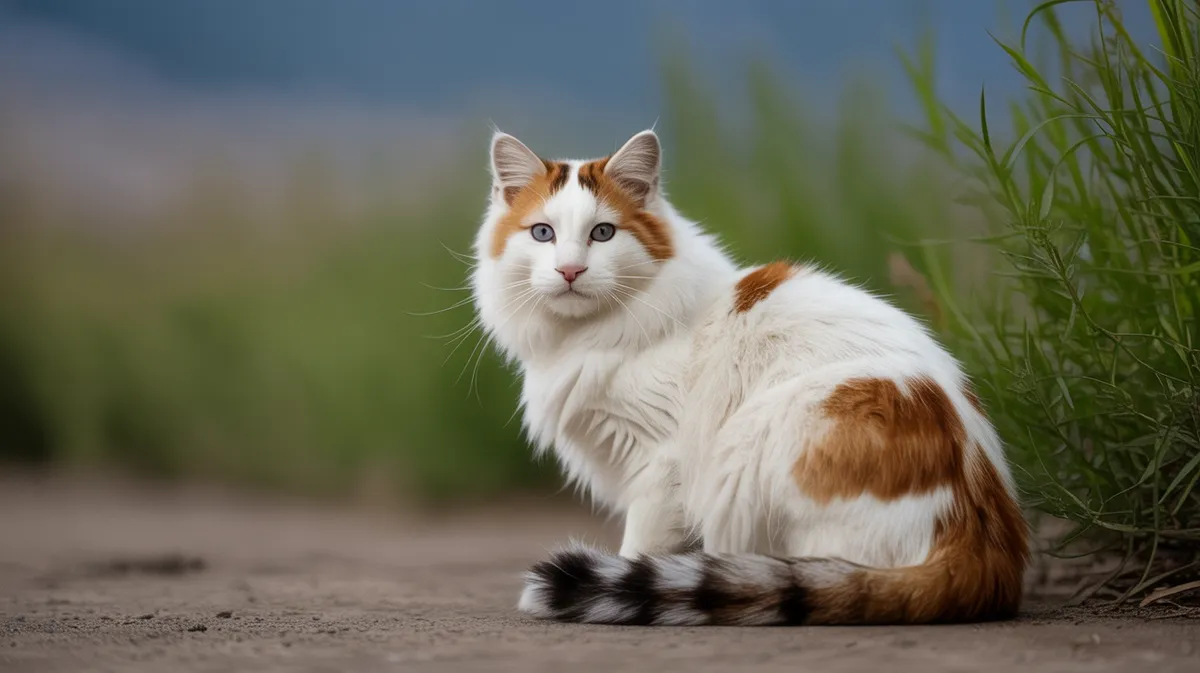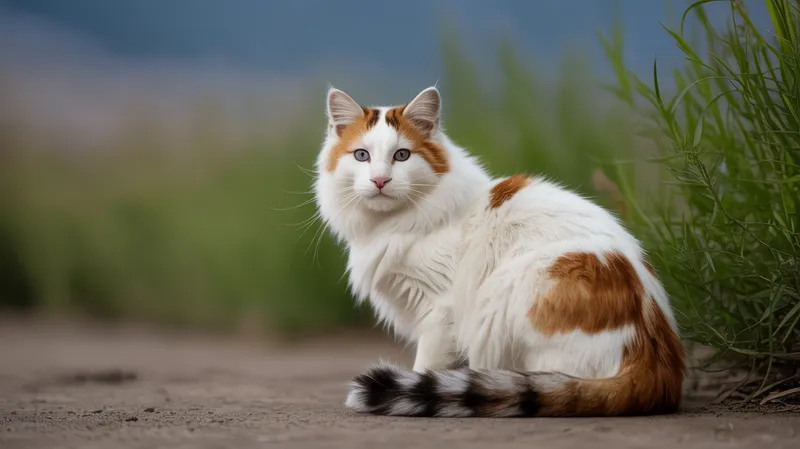
Turkish Van
Felis catus

Meet the Turkish Van
The Turkish Van is a natural domestic cat breed known for its distinctive semi-longhaired coat and striking coloration, often featuring a white body with colored markings on the head and tail. Originating from the Lake Van region in Turkey, this breed is renowned for its love of water, earning it the nickname 'swimming cat'. Turkish Vans are muscular, agile, and highly active, with a playful and intelligent personality. They are loyal to their families and often form strong bonds with their human companions.
Classification
Mammal
Habitat
Domestic, originally from the Lake Van region (mountainous and lakeside environments)
Diet
Carnivore
Lifespan
12-17 years
Conservation
Least Concern
Weight
3.5-9 kg
📖Fascinating Facts
Swimming Cat
Turkish Vans are one of the few cat breeds that enjoy swimming and playing in water, thanks to their water-resistant coats.
Unique Coloring
The distinctive 'Van pattern' includes a largely white body with color restricted to the head and tail, setting them apart from other breeds.
Ancient Origins
The breed originated around Lake Van in Turkey and is considered a national treasure in its homeland.
📋Detailed Description
The Turkish Van is a robust, medium-to-large domestic cat breed, notable for its muscular build, substantial bone structure, and semi-long, water-resistant coat. Adults typically weigh between 4.5–9 kg (10–20 lbs), with males generally larger than females. The breed is distinguished by the 'Van pattern': a predominantly white body with colored markings restricted to the head and tail, resulting from the expression of the piebald white spotting gene (S locus), a form of partial leucism. The coat is soft, lacking an undercoat, and changes seasonally—being fuller in winter and shorter in summer. Turkish Vans have a wedge-shaped head, moderately large ears set high, and expressive, oval eyes that may be amber, blue, or odd-eyed (heterochromia). Their tails are bushy and colored, often ringed. Anatomically, they possess powerful hind limbs, contributing to their agility and impressive jumping ability. Behaviorally, Turkish Vans are highly active, intelligent, and inquisitive, often displaying dog-like loyalty and strong attachment to their human families. They are renowned for their affinity for water, a rare trait among domestic cats, and are often observed playing in sinks, bathtubs, or even swimming. Socially, they are generally tolerant of other animals but may prefer a dominant or solitary role, and they thrive in environments that offer mental and physical stimulation.
💡 Did you know?
Unlike most cats, Turkish Vans are known to voluntarily enter water and swim for pleasure.
🔬Research & Sources
Wikipedia Summary
The Turkish Van is a semi-long-haired, standardised breed of domestic cat, which was developed in the United Kingdom from a selection of cats obtained from various cities of modern Turkey, especially southeast Turkey. The breed is rare, is one of the larger breeds, and is distinguished by the Van pattern, where the colour is restricted to the head and the tail, and the rest of the cat is white; this is due to the expression of the piebald white spotting gene, a type of partial leucism. A Turkish Van may have blue or amber eyes, or be odd-eyed.
Last Modified: 4/15/2025
🎭Behavior & Social Structure
Turkish Vans are energetic and playful, maintaining kitten-like activity levels well into adulthood. They exhibit strong hunting instincts, often engaging in stalking and pouncing behaviors with toys or small prey. Their feeding behavior is typical of domestic cats, but they may display food-motivated intelligence, such as learning to open cabinets or doors. Socially, Turkish Vans are affectionate with their chosen humans, often following them from room to room, but they may be reserved or aloof with strangers. They are known for their vocalizations, using a range of chirps and meows to communicate. Daily routines often include periods of intense activity interspersed with rest, and they benefit from interactive play and environmental enrichment. Their love of water manifests in behaviors such as pawing at water bowls, playing in running water, or even swimming, a trait that is hypothesized to have evolved in their native lakeside environment.
👶Reproduction & Life Cycle
Turkish Vans reach sexual maturity between 8–12 months of age. They are seasonally polyestrous, with breeding peaks typically in spring and summer. Females exhibit a gestation period of approximately 63–68 days, after which litters of 3–6 kittens are common. Queens display attentive maternal care, nursing and grooming their young until weaning at around 8–10 weeks. Kittens are born with white coats; colored markings on the head and tail develop gradually over the first few weeks. Responsible breeders select for the Van pattern and robust health, often using genetic testing to minimize inherited disorders. Turkish Vans are not prone to breed-specific reproductive issues, but as with all pedigreed cats, careful management is essential to maintain genetic diversity.
🛡️Adaptations & Survival
The Turkish Van's most distinctive adaptation is its affinity for water, supported by a unique, water-resistant coat texture that dries quickly and provides some insulation. The lack of an undercoat reduces matting and facilitates swimming. Their powerful hindquarters and muscular build enable strong leaping and climbing abilities, advantageous in their native mountainous and lakeside habitats. The Van pattern may offer camouflage benefits in snowy or rocky environments. Behaviorally, their high intelligence and curiosity are adaptive for problem-solving and environmental exploration. Their seasonal coat changes reflect adaptation to the variable climate of eastern Turkey.
📚Research Sources
🎨Cultural Significance
The Turkish Van holds a special place in Turkish folklore and regional identity, often associated with the Lake Van area. The breed is sometimes conflated with the Van cat (Van kedisi), a local landrace with similar coloration but distinct genetic heritage. In Turkish culture, these cats are regarded as symbols of good fortune and are featured in local legends, including tales of their swimming ability and unique markings. The 'swimming cat' reputation has contributed to their international appeal and mystique. Turkish Vans are also celebrated in art and literature, and their image is used to promote tourism in the Lake Van region.
🔬Recent Research & Discoveries
Recent genetic studies have clarified the distinction between the Turkish Van breed and the indigenous Van cat landrace, revealing that the standardized breed developed in the UK is genetically distinct from Turkish landrace populations. Research into the piebald spotting gene has contributed to understanding coat color inheritance and partial leucism in domestic cats. Ongoing studies focus on the breed's unique behavioral traits, particularly its affinity for water, with hypotheses suggesting both genetic and environmental influences. Conservation efforts in Turkey aim to preserve the original Van cat population, which is genetically and phenotypically diverse. There is also interest in the breed's resistance to certain diseases, possibly linked to its robust, natural origins.
🎥Wildlife Videos

My Turkey: The very special Turkish Van cats
The Turkish Van cat is a breed native to Turkey's eastern province of Van. A research centre in the city is dedicated to protecting ...
TRT World

11 Rarest Cat Breeds In The World
From rare and unique felines to incredible house cats you've never heard of before, here are the rarest cat breeds in the world.
Epic Wildlife

These Are All Cat Breeds That Currently Exist
PREVIOUS VIDEO: https://youtu.be/NiwJGDi5R9s Stay tuned in our Community: ...
ViralBe

Wild and WEIRD Cats #WeirdAnimals #UniqueAnimals - 8 Unusual Cat Breeds
Please be sure to… Like this video and Share to social media ✓ Subscribe to our channel 🛎️ Ring that notification bell to ...
Copper Owl's Nest

Fishing Cat: The Cat That Hunts Underwater
Life in the mangroves of South Asia is difficult, but there's one creature in this swamp that's defying the odds, and our expectations ...
Animalogic
🌍Habitat Information
The Turkish Van typically inhabits Domestic, originally from the Lake Van region (mountainous and lakeside environments) environments. Turkish Vans have adapted to their environments with specialized features and behaviors.
Primary Habitat:
Domestic, originally from the Lake Van region (mountainous and lakeside environments)
More detailed habitat information will be available soon.
🛡️Conservation Status
The Turkish Van is currently classified as Least Concern. Conservation efforts are crucial for preserving this species for future generations.
Common Threats:
- 🏠Habitat loss and fragmentation
- 🌡️Climate change impacts
- 🎯Hunting and poaching
- 🏭Human-wildlife conflict
⚠️Threats & Conservation Challenges
As a pedigreed breed, Turkish Vans are rare and face challenges related to limited genetic diversity, particularly outside their native region. Inbreeding and a small breeding population can increase susceptibility to hereditary diseases. The breed is not considered at risk in the wild, as it is fully domesticated, but the original landrace population in Turkey (Van kedisi) is declining due to habitat loss, interbreeding with other domestic cats, and reduced traditional breeding. There are no significant threats from predation or disease unique to the breed, but responsible breeding practices are essential to maintain health and vitality.
🔬Scientific Classification
Scientific Name
Felis catus
Classification Hierarchy
🔍 About Taxonomic Classification
Taxonomic classification is a hierarchical system used by scientists to classify and organize living organisms based on shared characteristics and evolutionary relationships.
The system moves from broad categories (Kingdom) to increasingly specific ones, with each animal's scientific name typically consisting of its Genus and species.
📝Community Notes
Share your observations and insights about the Turkish Van with our community of wildlife enthusiasts.
Join Our Community
Sign in to share your observations and connect with fellow wildlife enthusiasts.
Sign In to ContributeNo community notes yet
Be the first to share your observations about the Turkish Van!
Explore Turkish Van
Select a tab above to learn more about this amazing animal.
📸Photo Gallery
No photos available for this animal yet.
🌟Discover More Wildlife
Continue your journey of discovery with more fascinating animals from our database
